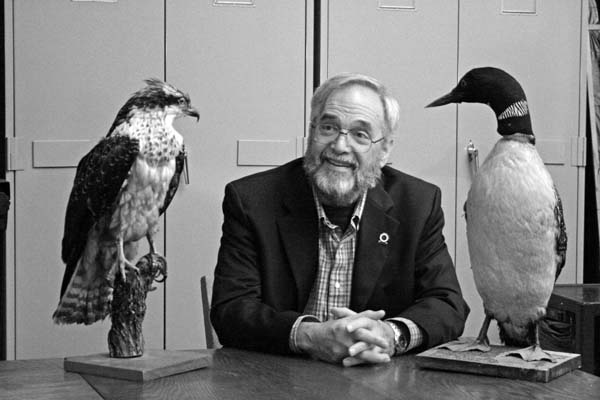Dr. Jay Buckelew
The Bird Man of Bethany
By Mort Gamble / Photographs by Ashly Campbell

Dr. Albert R. "Jay" Buckelew, Jr., with an osprey and a loon at Bethany College. Photograph by Ashly Campbell.
Some years ago, ornithologist Dr. Albert R. “Jay” Buckelew, Jr., hiked through the unmarked, backwater trails of the Trough, a scenic, mysterious section of the South Branch of the Potomac River flowing north between Moorefield and Romney. [See “Our Cruise on the South Branch: The Log Book (July 13-27, 1919),” by Harold Field; Summer 1998.] He was in search of something that few knew was there, something that he himself had never seen.
The Trough is surrounded by steep mountainsides, stands of forest, and the occasional farm clearing. Its waters alternate between small sets of barely navigable rapids and deep pools that go by such local names as the “Blue Hole.” Beautiful but hardly inviting, the terrain is largely inaccessible except by ATV, boat, or rail. On this day in June of 1982, the South Branch Valley Railroad, traveling a former spur line of the B&O, brought Jay and some 70 of his fellow scientists and wildlife enthusiasts from the Brooks Bird Club to a place so remote and rugged that it could have aptly — and literally — been known as a place where only eagles dared.
For it was Haliaeetus leucocephalus, the American bald eagle, still endangered then, the target of misguided shooters, its fragile eggs long the victims of the pesticide DDT, that Jay had come to see and to study. A professor of biology at Bethany College, Jay had heard there was a nesting pair of eagles in the Trough — probably the first successful nest in the state in modern times — working their way upstream from the Washington, D.C., area into the Potomac watershed. Accustomed to extreme hiking to find rare species of wildlife, Jay was determined to see them.
Fairly common in West Virginia now, bald eagles were still a rare sight throughout the Eastern U.S. when Jay approached the railroad about transporting him and his party, camping nearby on one of the forays of the Brooks Bird Club, deep into the Trough in search of the living symbol of America. They could walk back in there, but such a journey would take a toll on the less able-bodied of the group.
“I thought, wow, wouldn’t it be neat if we could get in there and see the nest?” Jay recalls. “The railroad went through, and my idea was to get permission to walk over the South Branch on its railroad bridge. We could walk up the track and view the nest.”
After first consulting with the West Virginia Department of Natural Resources, Jay sold the railroad officials in Moorefield on his idea.
As Jay and others who rode the special train approached the nest site, they were joined by those who managed the trip on foot. “We walked up to and above the nest, and looked so we could see into it,” Jay remembers. “I’d never seen an eagle nest up close like that.” An immature eagle, black and without the familiar white-feathered crown of adult specimens, was perched on the nest.
What Jay saw next was totally unexpected, even for an experienced biologist. “The ground below the nest was littered with box turtle shells,” he says. Eagles may look majestic, Jay explains, but they are also opportunistic scavengers. “I couldn’t imagine there were that many turtles in that area,” he marvels. “They sure had picked up a bunch of those.”
About a year later, the railroad started offering regular tourist excursions into the same area to see the Trough’s star attractions. The special train is now known as the Potomac Eagle.
Jay sits back in a comfortable chair at Bethany College’s Erickson Alumni Center and continues talking about his favorite subject, one that has filled and directed his life for more than half a century. It’s plain to see why, when he retired in 2011 after 42 years as a member of the biology faculty at Bethany, he couldn’t let go of his passion — birds.
You can read the rest of this article in this issue of Goldenseal, available in bookstores, libraries or direct from Goldenseal.